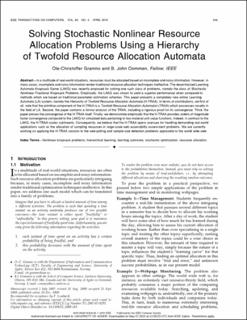| dc.contributor.author | Granmo, Ole-Christoffer | |
| dc.contributor.author | Oommen, B. John | |
| dc.date.accessioned | 2010-11-29T12:31:26Z | |
| dc.date.available | 2010-11-29T12:31:26Z | |
| dc.date.issued | 2010 | |
| dc.identifier.citation | Granmo, O.-C. & Oommen, B.J. (2010) Solving Stochastic Nonlinear Resource Allocation Problems Using a Hierarchy of Twofold Resource Allocation Automata. IEEE transactions on computers, 59(4), 545-560. | en_US |
| dc.identifier.issn | 1557-9956 | |
| dc.identifier.uri | http://hdl.handle.net/11250/137839 | |
| dc.description | Published version of an article in the journal: IEEE Transactions on Computers. Personal use of this material is permitted. Permission from IEEE must be obtained for all other users, including reprinting/ republishing this material for advertising or promotional purposes, creating new collective works for resale or redistribution to servers or lists, or reuse of any copyrighted components of this work in other works | en_US |
| dc.description.abstract | In a multitude of real-world situations, resources must be allocated based on incomplete and noisy information. However, in many cases, incomplete and noisy information render traditional resource allocation techniques ineffective. The decentralized Learning Automata Knapsack Game (LAKG) was recently proposed for solving one such class of problems, namely the class of Stochastic Nonlinear Fractional Knapsack Problems. Empirically, the LAKG was shown to yield a superior performance when compared to methods which are based on traditional parameter estimation schemes. This paper presents a completely new online Learning Automata (LA) system, namely the Hierarchy of Twofold Resource Allocation Automata (H-TRAA). In terms of contributions, we first of all, note that the primitive component of the H-TRAA is a Twofold Resource Allocation Automaton (TRAA) which possesses novelty in the field of LA. Second, the paper contains a formal analysis of the TRAA, including a rigorous proof for its convergence. Third, the paper proves the convergence of the H-TRAA itself. Finally, we demonstrate empirically that the H-TRAA provides orders of magnitude faster convergence compared to the LAKG for simulated data pertaining to two-material unit-value functions. Indeed, in contrast to the LAKG, the H-TRAA scales sublinearly. Consequently, we believe that the H-TRAA opens avenues for handling demanding real-world applications such as the allocation of sampling resources in large-scale Web accessibility assessment problems. We are currently working on applying the H-TRAA solution to the web-polling and sample-size detection problems applicable to the world wide web. | en_US |
| dc.language.iso | eng | en_US |
| dc.publisher | IEEE | en_US |
| dc.title | Solving Stochastic Nonlinear Resource Allocation Problems Using a Hierarchy of Twofold Resource Allocation Automata. | en_US |
| dc.type | Journal article | en_US |
| dc.type | Peer reviewed | en_US |
| dc.source.pagenumber | 545-560 | en_US |
| dc.identifier.doi | https://doi.org/10.1109/TC.2009.189 | |
